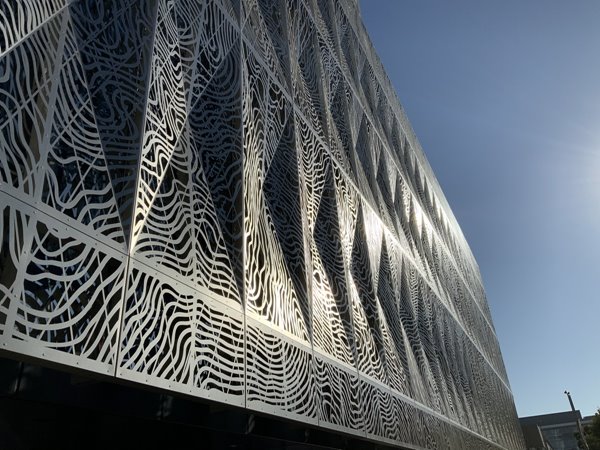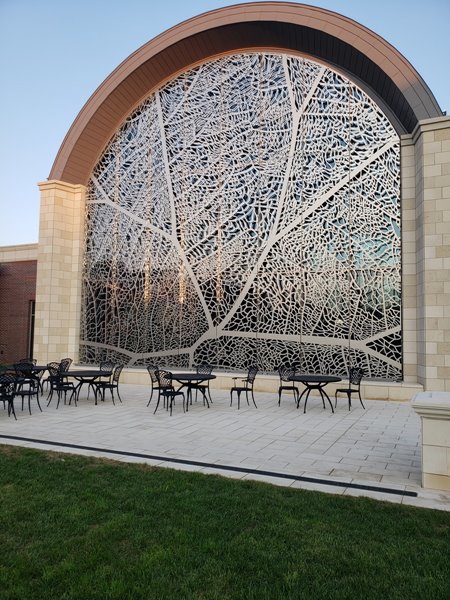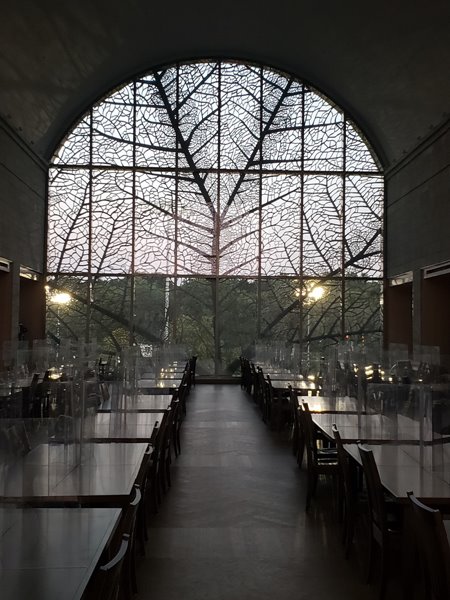Crafting Metal Works of Art
Artists make unique clients for A. Zahner Co., which has extensive experience in this area.
 In 2007, L. William Zahner, CEO of A. Zahner Company of Kansas City, Missouri, collaborated with Jan Hendrix, a world-famous Dutch artist based in Mexico City, on the Art Wall of Doha in Qatar. “Jan and I became good friends,” Zahner says. Sixteen years and over 20 projects later, Hendrix spends so much time in Zahner’s shop that people might think he works there.
In 2007, L. William Zahner, CEO of A. Zahner Company of Kansas City, Missouri, collaborated with Jan Hendrix, a world-famous Dutch artist based in Mexico City, on the Art Wall of Doha in Qatar. “Jan and I became good friends,” Zahner says. Sixteen years and over 20 projects later, Hendrix spends so much time in Zahner’s shop that people might think he works there.
Hendrix is one of dozens of artists who collaborate with Zahner to create massive artwork. “We sit down with the artist and discuss how he created different things, which opens almost endless possibilities,” Zahner says. “They challenge us, and we challenge them. Big ideas come from pushing the boundaries and trying things that haven't been done before. It’s fun because everything is different; everything is new. You're always learning something you didn't know before.”
Zahner loves the window shades Hendrix designed for the Pembroke Hill School cafeteria in Kansas City, Missouri. In fact, he installed a sample in his office. “One of the first iterations is on one of my windows. We had the clients over, and they wanted to see what it looks like,” Zahner explains. “We help the artist develop the concept. He draws it all out, and we convert it to machine language. He may do 10 different iterations, and then we make a prototype so the client experiences it.”
 The two 40-foot by 40-foot shades are on opposite windows of the Pembroke Hill cafeteria. Each window has two layers for a total of 6,400 square feet of 14-gauge stainless steel. The project took a team of eight people about 18 months to complete. “We were able to put up a beautiful piece of art for little more than normal sunshades,” Zahner says. “Hendrix wanted the students to feel like they are inside a leaf.” The challenge was to keep the flowing, organic pattern within rectangular panels. “It has to be strong enough to resist loading and gravity, but we can't make the structure so pronounced that it hides the art.”
The two 40-foot by 40-foot shades are on opposite windows of the Pembroke Hill cafeteria. Each window has two layers for a total of 6,400 square feet of 14-gauge stainless steel. The project took a team of eight people about 18 months to complete. “We were able to put up a beautiful piece of art for little more than normal sunshades,” Zahner says. “Hendrix wanted the students to feel like they are inside a leaf.” The challenge was to keep the flowing, organic pattern within rectangular panels. “It has to be strong enough to resist loading and gravity, but we can't make the structure so pronounced that it hides the art.”
The facade of the Mexican Museum in San Francisco is also approximately 40 feet tall. However, it’s also 100 feet long and wraps around the sides of the building. The façade is inspired by a topography map of the landscape from Mexico to San Francisco. It has two distinct layers for a total of 24,000 square feet of stainless steel and took 15 craftspeople 36 months to complete. Each of the 330 rectangular panels is made of four triangles folded together. “This kind of folded plate pattern leans toward Mexican or Aztec design,” says Zahner. The interior layer is different from the exterior, so the wall appears to change as pedestrians walk by. “It adds a level of complexity to the surface and makes it more interesting than a flat wall.”
Every single opening of a Hendrix creation is unique. “We help the laser manufacturers in Germany create part of the code the machine uses to cut these because they're so complex,” Zahner says. “The other thing we do is analyze each cutout shape from a budget standpoint.” Zahner’s team saves money with slight design modifications that allow for faster work. “The Pembroke windows cut very slowly while the long openings in the Mexican Museum façade cut quickly.”
 Waste metal often tips as it drops away from the sheet, which triggers the laser sensors. “When the lasers have an interference, they go all the way back to the beginning of the program,” Zahner says. “You can imagine the frustration of restarting, but we conquered that.” It’s also a problem when laser cuts begin on an edge. “We want the initial cut in a place that's going to be recycled and removed, not an edge.”
Waste metal often tips as it drops away from the sheet, which triggers the laser sensors. “When the lasers have an interference, they go all the way back to the beginning of the program,” Zahner says. “You can imagine the frustration of restarting, but we conquered that.” It’s also a problem when laser cuts begin on an edge. “We want the initial cut in a place that's going to be recycled and removed, not an edge.”
Due to strength characteristics, these projects usually use stainless steel, but Zahner has also worked in zinc. “For one, we’re doing with Jan right now,” he says, “we're going to carve black anodized aluminum so that you get the offset of the reflective surface below.”
“Working with artists is different than working with an owner or a client because the artist becomes very engaged with your people,” Zahner says. “There's no change order aspect, and the relationship is much cleaner.” Some artists are so passionate that they short themselves financially. “We always want the artists to succeed, and it's a must that the artist makes money. We want to make them famous.” He couldn’t succeed without his staff. “Our craftspeople make it possible to compete anywhere in the world. We don't want our name on it unless it's perfect.”
Published: March 21, 2023
IN THIS ISSUE
Between the Lava and the Rain
Hawaii Sheet Metal & Mechanical works amid the challenges of an active volcano.
Crafting Metal Works of Art
Artists make unique clients for A. Zahner Co., which has extensive experience in this area.
Effective High-end Residential Strategies
T.H. Martin shares eight tips for working on condos, apartments and hybrid spaces.
How SMACNA Is Increasing Engagement Opportunities
Measuring and evaluating engagement and utilizing that information to tailor programming to the needs of members is now more important than ever.
HVAC for U.S. Air Force Hangars
United Mechanical tackles its fifth hangar project — the KC-46A Three Bay Maintenance Hangar at Tinker Air Force Base in Midwest City, Oklahoma.
Inside SMACNA's 2023 Strategic Plan
SMACNA’s CEO discusses the new strategic plan and how it will strengthen SMACNA’s position with key stakeholders.
Opportunity Is In The Air
Assuring clean air in buildings is becoming an essential service, and members can easily gain the tools to perform in-demand ventilation verification work.
State Marijuana Laws May Pose Security Clearance Problems for Contractors
In recent years, states have moved quickly to pass laws legalizing marijuana. To date, 21 states have legalized recreational marijuana and an additional 16 states have authorized marijuana for medical use.
State of the Union Response & GSA Carbon Scoring Rule Updates
Both chambers were in session in early February for the State of the Union legislative week. On Feb. 7, President Biden gave the State of the Union address to a pre-pandemic-sized crowd in the House chambers.
The Weakest Link?
With an uncertain supply chain that still seems broken, many SMACNA contractors are turning to stockpiles and substitutions to keep projects and profits on track.
Top Contractor Strategies for 2023: Part 1
With 2023 well underway, there is still a lot of noise in the world today that detours business owners from charting a confident course through this new year.
Understanding Possible Targets of Cyberattacks
With reports telling us that cyberattacks have been perpetually on the rise, and with the cybersecurity industry not only short millions of qualified professionals but also suffering from burnout, preparing for attacks is getting tougher.
Welcome New SMACNA Members
Welcome New SMACNA Members


